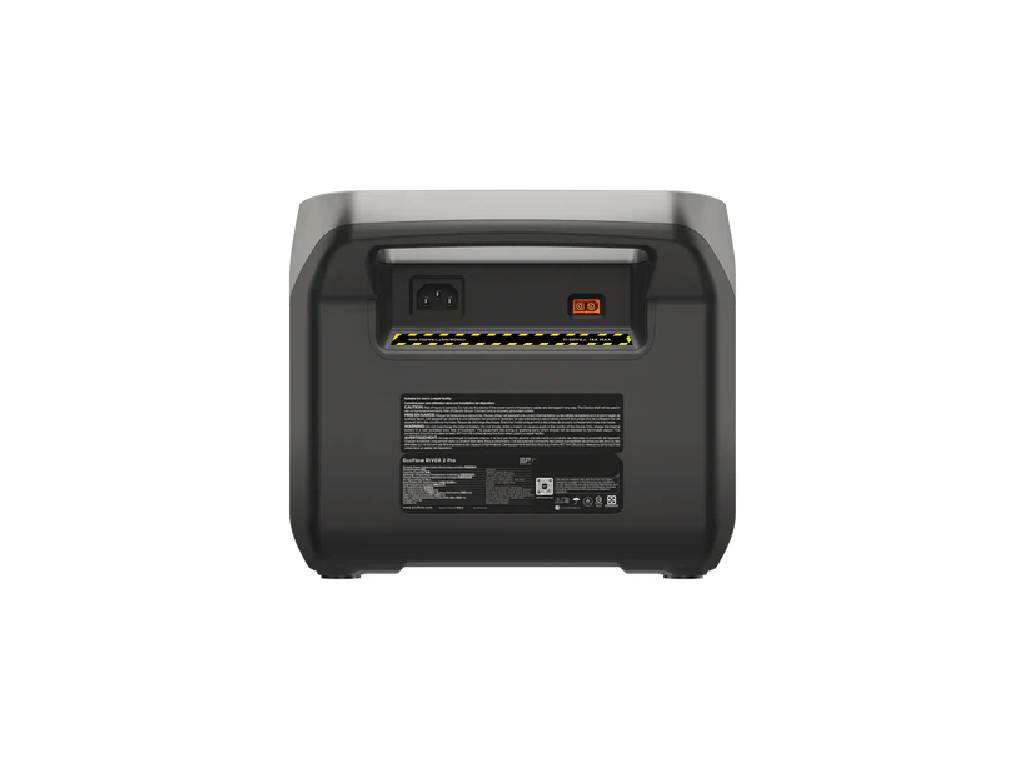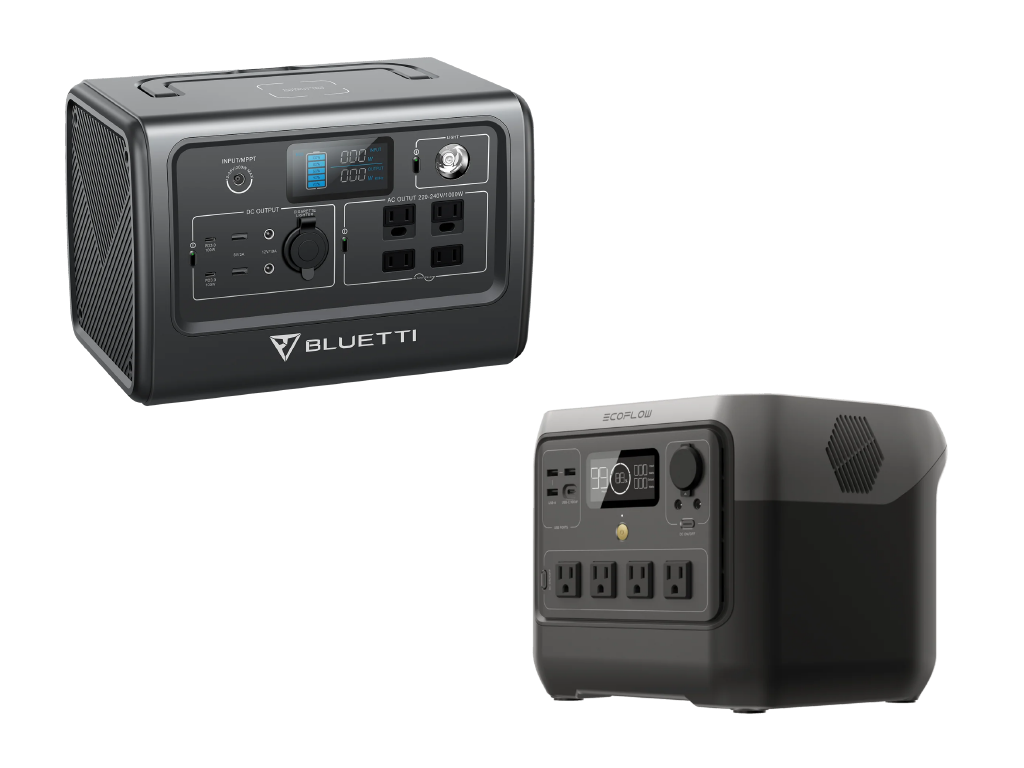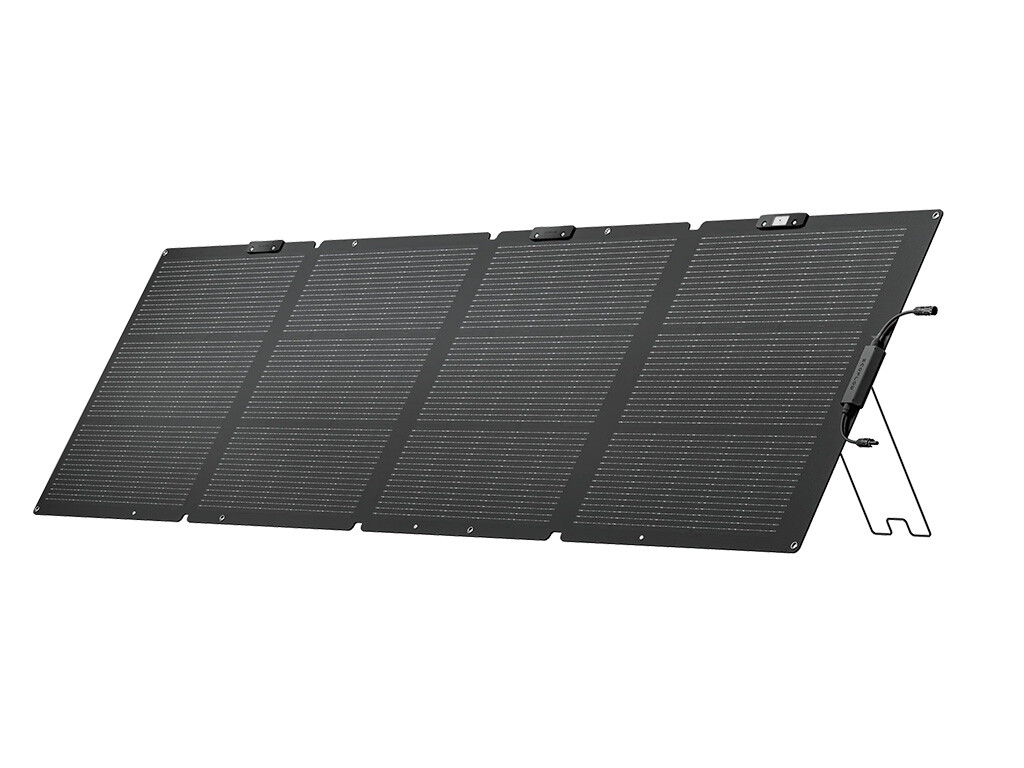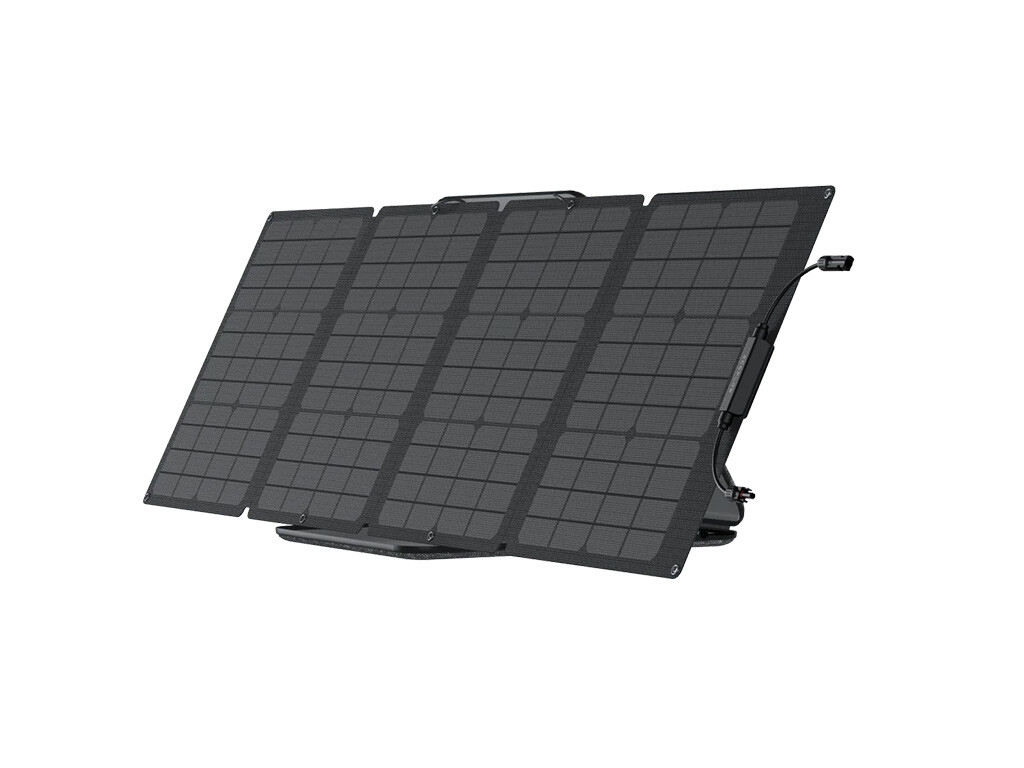Wondering which to choose between the EcoFlow River 2 Pro vs. Bluetti EB70 as your portable power station? Both units boast robust capabilities with LFP batteries and 800W Pure Sine Wave AC inverters, yet they are far from identical.
This detailed comparison breaks down everything from product specs and battery types to key features and warranty coverage. It has all you need to make the best decision to power your adventures or keep your critical devices alive during a power outage.
We carefully select the products and services we link to. If you buy through our links, we may earn a commission. There’s no extra cost to you and it helps us provide this information.

The Quick Rundown
EcoFlow River 2 Pro and Bluetti EB70 are both strong contenders in the portable power station market, but overall, EcoFlow takes the lead because:
- The EcoFlow River 2 Pro battery is larger by over 50Wh
- Much faster charging from home outlets (~1 hr vs 4 hrs)
- Wireless control through EcoFlow app
- 3 more years longer warranty
- Weighs about 20% less
All of these reasons make EcoFlow pull ahead in this race. However, the Bluetti EB70 power station holds its own as a very similar solar generator with a nearly-identical AC inverter and a very similar battery.
Plus, the Bluetti EB70 and the EB70S have a couple advantages. It features a convenient wireless charging pad and one more USB-C port (2 in total), making it a more tech-forward choice.
Note: The difference between the Bluetti EB70 vs. EB70S is the inverter size, with the EB70 featuring a 700W inverter and the EB70S featuring an 800W inverter. In some markets, the EB70S has taken over as the main offering from Bluetti. This article covers both options.
While the EcoFlow River 2 Pro and Bluetti EB70S share many similarities in their design and basic functionality, the EcoFlow edges out slightly ahead due to its larger battery capacity, significantly faster AC charging time, and the added convenience of app connectivity, not to mention its more generous 5-year warranty. However, if a wireless charging pad and the need for an extra USB-C port are high on your priority list, the Bluetti EB70 could be the more fitting choice.

|
EcoFlow RIVER 2 Pro |
R2P on EcoFlow R2P on Amazon |

|
BLUETTI EB70S Portable Power Station |
EB70S on Bluetti EB70S on Amazon |
EcoFlow River 2 Pro vs. Bluetti EB70
Let’s break down the EcoFlow River 2 Pro specs and Bluetti EB70 specs into practical insights you can understand.

Battery Performance Insight
The EcoFlow River 2 Pro battery and the Bluetti EB70S battery both utilize lithium iron phosphate (LFP or LiFePO4) battery chemistry, renowned for its safety and longevity. This is the gold standard in the industry and is found in the best power stations and solar generators.
The sizes are very similar, but EcoFlow’s 768Wh does beat Bluetti’s 716Wh. This 52Wh difference is about 7% and could charge a phone nearly 5 times.
In practical terms, the EcoFlow River 2 Pro battery can:
- Charge a typical phone >60 times or a laptop about 10 times
- Run a portable refrigerator for >25 hours (25W average draw)
- Keep an LED light on for multiple days
The Bluetti battery knocks that down to ~55 phone charges, 23 hours of refrigeration, and still multiple days for an LED light.
EcoFlow advertises the River 2 Pro battery as being able to handle up to 3,500 cycles with at least 80% of its original capacity, while Bluetti drops that down to 3,000 cycles. Since they both use the same LFP technology, this difference may be less significant than these advertised rates.
For camping enthusiasts, the EcoFlow River 2 Pro battery is a reliable companion, ensuring you can power essential devices like portable coolers, lights, and even a small TV for those longer stays in the wilderness. On the other hand, the Bluetti EB70S battery is also a solid choice, especially for shorter trips where a wireless charging pad and extra USB-C port might prove more beneficial. Pairing either one with 200W of solar will help dramatically.
Either can also work as a small home backup power, keeping critical devices like routers, fans, and low-powered medical equipment running during shorter outages. But these devices are no match for the best home battery backup power stations.
Verdict: The EcoFlow battery comes out ahead by about 7% or 52Wh, but overall, these are still very similar battery packs that are great for camping trips or limited home use.
| Feature | EcoFlow River 2 Pro | Bluetti EB70 and EB70S |
| Battery Capacity | 768Wh | 716Wh |
| Extra Batteries (external) | None | None |
| Battery Chemistry | LFP / LiFePO4 | LFP / LiFePO4 |
| Battery Cycles with 80% | 3,500 | 3,000 |

Inverter Essentials Explained
The inverter in a portable power station converts DC power from the battery into AC power, which is what comes out of standard home outlets. The rating of the inverter indicates the maximum wattage it can supply to your devices at one time.
Both the EcoFlow River 2 Pro and the Bluetti EB70S feature an 800W AC inverter. And both are pure sine wave inverters, providing the clean, stable power that sensitive electronics need. The inverters are essentially identical.
They also both have 4 outlets for the AC inverter. There is a small difference though: all of the EcoFlow’s AC outlets include the third opening for the grounding pole (the circular prong on the AC plug). Only two of the Bluetti’s outlets have this opening and the other two are for ungrounded devices.
The difference between the Bluetti EB70 and Bluetti EB70S is that the EB70 only has a 700W inverter.
Tip: Certain household devices must use AC power if they only have a regular plug for AC outlets. But many portable devices, including phones, tablets, and small battery packs, can use the USB ports without the inverter. This is a more efficient method to get the most out of your power station battery.

This 800W continuous rating means you can reliably power small appliances like laptops, CPAP machines, or even a coffee maker. It can easily power most portable refrigerators and can even handle a full-size fridge, but the battery won’t last long with a full-size fridge (~2-3 hours).
Inverters usually offer a peak output as well, which helps manage the large draws some devices use to start. The Bluetti inverter has a standard 1,400W peak output to handle those times.
The EcoFlow River 2 Pro inverter has an X-Boost feature that theoretically allows devices up to 1,600W to run. To do this, it reduces voltage to increase wattage. That can be fine for some devices like motors and heaters, which will run slower or provide less heat. But it won’t work for many sensitive electronics, such as microwaves. It’s better to buy a power station with an inverter continuous rating that matches your devices rather than rely on this unique function.
From powering tools at a remote job site to keeping entertainment devices running during a camping trip, these inverters can provide what you need, up to 800W.
Verdict: The inverters in both the EcoFlow River 2 Pro and the Bluetti EB70S are identical at 800W. The Bluetti EB70 has a 700W inverter, slightly less powerful but not dramatically.
| Feature | EcoFlow River 2 Pro | Bluetti EB70 and EB70S |
| AC Output | 800W Pure Sine Wave | 800W EB70S / 700W EB70 Pure Sine Wave |
| AC Peak Output | 1,600W (X-Boost voltage reduction) | 1,400W (short-term standard peak) |
| AC Outlets | 4 | 4 |

Charging Inputs Uncovered
Charging inputs on portable power stations determine how quickly you can recharge the unit itself, using either AC (from wall outlets) or DC (solar panels, car 12V outlets, and other off-grid energy sources). The specifications are the maximum power the device can accept at one time for recharging the internal battery. The higher the rating, the faster it can recharge.
The EcoFlow River 2 Pro stands out with its exceptionally fast AC charging capability at 940W. This will charge the battery from 0% to 100% in just 70 minutes, an incredible feat. For solar charging, it can handle up to 220W of input, enabling full recharge in 4-6 hours depending on sunlight conditions.
The Bluetti EB70 offers a more modest AC charging rate of 200W. This translates to around 4 hours to fully charge. Its solar charging capacity is comparable to the EcoFlow but still slightly lower, accepting up to 200W and achieving full charge in 4-7 hours, depending on solar conditions.
This AC recharge rate difference might not be a big problem for too many people. Just make sure to charge it about 4-5 hours before your trip. But for last-minute charging, the EcoFlow is a standout.

However, if you want to use the device as a pass-through backup emergency power supply (EPS), the Bluetti AC charge input can be a problem. For one, it’s not a true pass-through and will actually be converted to DC to charge the battery, then converted back to AC for the inverter. Also, if you use more than 200W, you will be running down the battery faster than it can recharge.
Note: Neither the EcoFlow River 2 Pro nor the Bluetti EB70S function as a true uninterruptible power supply (UPS). The EcoFlow has pass-through AC charging but still has a 20 ms delay to switch from AC input to battery backup. This might cause some computers to reboot. It also uses the battery to power internal electronics, an intended function of most EcoFlow devices in pass-through mode. Bluetti’s is more limited, as described above.
These differences highlight the EcoFlow River 2 Pro’s advantage in rapid AC charging, ideal for users who need to quickly replenish power or want to use it as an EPS. However, both units provide similar flexibility with solar charging, making them suitable for off-grid applications or eco-friendly energy replenishment during outdoor adventures.
Verdict: EcoFlow wins big with rapid AC charging that is ahead of most power stations of this size and an EPS pass-through function with 20 ms switchover. They are almost identical for DC charging like solar, but EcoFlow is still 20W faster.
| Feature | EcoFlow River 2 Pro | Bluetti EB70 and EB70S |
| AC Charging Rate | 940W @ 120V | 200W @ 120V |
| Pass-Through AC Charging | Yes | No |
| EPS Function | Yes, 20 ms switchover | No |
| UPS Function | No | No |
| Solar Charging Rate | 220W (11-50V, 13A) | 200W (12-28V, 8A) |

Additional Features Breakdown
When it comes to the overall utility and convenience of portable power stations, the number of ports, app connectivity, warranty coverage, and additional functionalities play a significant role. Both the EcoFlow River 2 Pro and the Bluetti EB70 offer a range of features, each tailored to different user needs.
The EcoFlow River 2 Pro is equipped with:
- 4 AC outlets, all with grounding pole
- 3 USB-A ports
- 1 USB-C port
- 12V car port
- 17.2 lbs / 7.8 kg
The Bluetti EB70S has:
- 4 AC outlets, 2 with grounding pole and 2 without
- 2 USB-A ports
- 2 USB-C ports
- 12V car port
- Wireless charging pad
- 21.4 lbs / 9.7 kg
The extra USB-C and wireless charging pad are the two features where the Bluetti EB70 has an advantage over the River 2 Pro.
EcoFlow hits back with app connectivity, longer warranty, and lighter weight. You can monitor and control the power station remotely via the EcoFlow app, which works through Bluetooth or WiFi. You can connect to it wirelessly whether you’re deep in the wilderness but within Bluetooth range, or if you’re on the other side of the world using WiFi.
Additionally, EcoFlow provides a robust 5-year warranty, offering peace of mind and confidence in the product’s reliability over time. Bluetti only has a 2-year warranty for the EB70 and EB70S. At 3,000 cycles of battery recharging, this 2 years can be much shorter than the expected lifespan.
Both models ensure that you have ample connectivity for a variety of devices and situations, whether you’re camping, working remotely, or preparing for emergencies. The choice between the two may come down to specific preferences like the need for wireless charging or the desire for longer warranty and advanced app management.
Verdict: The Bluetti EB70S comes out ahead with an extra USB-C port and a wireless charging pad. But EcoFlow includes app connectivity and 3 extra years of warranty coverage.
| Feature | EcoFlow River 2 Pro | Bluetti EB70 and EB70S |
| AC Outlets | 4 | 4 |
| USB Ports | 3 x USB-A; 1 x USB-C | 2 x USB-A; 2 x USB-C |
| Wireless Charging Pad | None | 1 x 15W |
| App Connection | Yes, WiFi & Bluetooth | No |
| Warranty | 5-year | 2-year |
| Weight | 17.2 lbs / 7.8 kg | 21.4 lbs / 9.7 kg |
| Dimensions | 10.6 x 10.2 x 8.9 in 270 x 260 x 226 mm | 12.6 x 8.5 x 8.7 in320 x 216 x 221 mm |
Final Verdict
The EcoFlow River 2 Pro shines with its rapid charging, extensive app control, and longer warranty, making it ideal for those who value quick preparation and long-term reliability. It also has a slightly larger battery and better pass-through AC functions.
The Bluetti EB70 brings a wireless charging pad and additional USB-C port, perfect for tech-savvy users who prioritize convenience. But the AC charging rate leaves something to be desired, as does the shorter warranty coverage.
Both offer robust performance, but your choice will ultimately hinge on which features best align with your lifestyle and requirements.

Solar Panel Recommendations
To turn either portable power station into a solar generator, get the right solar panels. Pay attention to the solar charging input of each device. Maximizing it or over-paneling is the best way to ensure your battery stays full.
Caution: Never go over the maximum voltage accepted by the power station and be aware that cold weather can cause solar panels to put out higher voltage than listed. Read this article about connecting multiple solar panels and dealing with series vs. parallel.
For the EcoFlow River 2 Pro, the maximum solar input is 220W. And it allows for an impressive voltage range of 11-50V at 13A. If you want, you can connect more than 220W of solar panels as long as you stay under 50V. This is called over-paneling and will help provide maximum charging (up to 220W) even when the sun is low in the sky or during cloudy weather. The best EcoFlow solar panels to use with the River 2 Pro are:
- 1x EcoFlow NextGen 220W Portable Solar Panel: Integrated solar guide, impressive 25% efficiency, only need one panel, will charge battery in about 4 hours under ideal conditioners with peak sunlight. This is available as a bundle with the River 2 Pro (listed below).
- 2x EcoFlow 110W Portable Solar Panel: More affordable with IP68 waterproof rating, but need at least two to get the same 4-hour charge rate. Can use one 110W panel, but it will take ~8 hours of peak sunlight (more than one day has in most places)
- 1x EcoFlow NextGen 220W Bifacial Portable Solar Panel: With a 220W panel on front and a 175W panel on the backside, you can capture up to 28% more energy but still use one panel that’s the same size as the regular 220W. And it’s within the River 2 Pro’s charging limits, but slightly overpaneled to maximize charging rate.

|
EcoFlow RIVER 2 Pro Solar Generator with 220W Portable Panel |
Buy on EcoFlow Buy on Amazon |

|
EcoFlow NextGen 220W Portable Solar Panel |
Buy on EcoFlow |

|
EcoFlow 110W Portable Solar Panel |
Buy on EcoFlow Buy on Amazon |

|
EcoFlow NextGen 220W Bifacial Portable Solar Panel |
Buy on EcoFlow |

The Bluetti EB70S can handle up to 200W, but with a more limited 12-28V at 8A. Be careful when connecting more than one solar panel as you can easily go over this voltage with many panels, including Bluetti. Here are the best Bluetti solar panels to use with the EB70S and EB70:
- 1x BLUETTI 200W Portable Solar Panel: Up to 23.4% efficiency, just barely under the voltage limits at 26.5Voc, can charge battery in about 4 hours under ideal conditions with peak sunlight
- 1x BLUETTI 120W Portable Solar Panel: A more affordable way to get that will fully charge the battery in about 6.5 hours in ideal conditioners. You CANNOT connect two of these because a series connection goes over EP70 acceptable voltage (24.4V for each panel x 2 = 48.8V) and parallel goes over EB70 acceptable amperage (6.43A for each panel x 2 = 12.86A)

|
BLUETTI EB70S + 1*PV200 Solar Generator Kit |
Buy on Bluetti Buy on Amazon |

|
BLUETTI 200W Portable Solar Panel |
Buy on Bluetti Buy on Amazon |

|
BLUETTI 120W Portable Solar Panel |
Buy on Bluetti Buy on Amazon |
Full EcoFlow Specs vs. Bluetti Specs
Here’s a summary of all the specifications that matter most for these two solar generators. You can also head over to these posts to see the full lineup of EcoFlow specs and products or Bluetti specs and products, including the power stations, solar panels, and accessories.
| Feature | EcoFlow River 2 Pro | Bluetti EB70 and EB70S |
| Battery Capacity | 768Wh | 716Wh |
| Extra Batteries (external) | None | None |
| Battery Chemistry | LFP / LiFePO4 | LFP / LiFePO4 |
| Battery Cycles with 80% | 3,500 | 3,000 |
| AC Output | 800W Pure Sine Wave | 800W EB70S / 700W EB70 Pure Sine Wave |
| AC Charging Rate | 940W @ 120V | 200W @ 120V |
| Pass-Through AC Charging | Yes | No |
| EPS Function | Yes, 20 ms switchover | No |
| UPS Function | No | No |
| Solar Charging Rate | 220W (11-50V, 13A) | 200W (12-28V, 8A) |
| AC Outlets | 4 | 4 |
| USB Ports | 3 USB-A; 1 USB-C | 2 USB-A; 2 USB-C |
| Wireless Charging Pad | None | 1 x 15W |
| App Connection | Yes, WiFi & Bluetooth | No |
| Warranty | 5-year | 2-year |
| Weight | 17.2 lbs / 7.8 kg | 21.4 lbs / 9.7 kg |
| Dimensions | 10.6 x 10.2 x 8.9 in 270 x 260 x 226 mm | 12.6 x 8.5 x 8.7 in 320 x 216 x 221 mm |
User Manuals
Here are the links to the user manuals for these two portable power stations:

|
EcoFlow RIVER 2 Pro Solar Generator with 220W Portable Panel |
Buy on EcoFlow Buy on Amazon |

|
BLUETTI EB70S + 1*PV200 Solar Generator Kit |
Buy on Bluetti Buy on Amazon |

|
EcoFlow RIVER 2 Pro |
R2P on EcoFlow R2P on Amazon |

|
BLUETTI EB70S Portable Power Station |
EB70S on Bluetti EB70S on Amazon |
Wrap Up
In the matchup between the EcoFlow River 2 Pro and the Bluetti EB70, both power stations offer impressive features but the EcoFlow comes out ahead in battery size, charging speed, and warranty. Bluetti has a wireless charging pad and an extra USB-C port.
Head over to EcoFlow or Bluetti to get your device today and be ready for your portable power needs.







